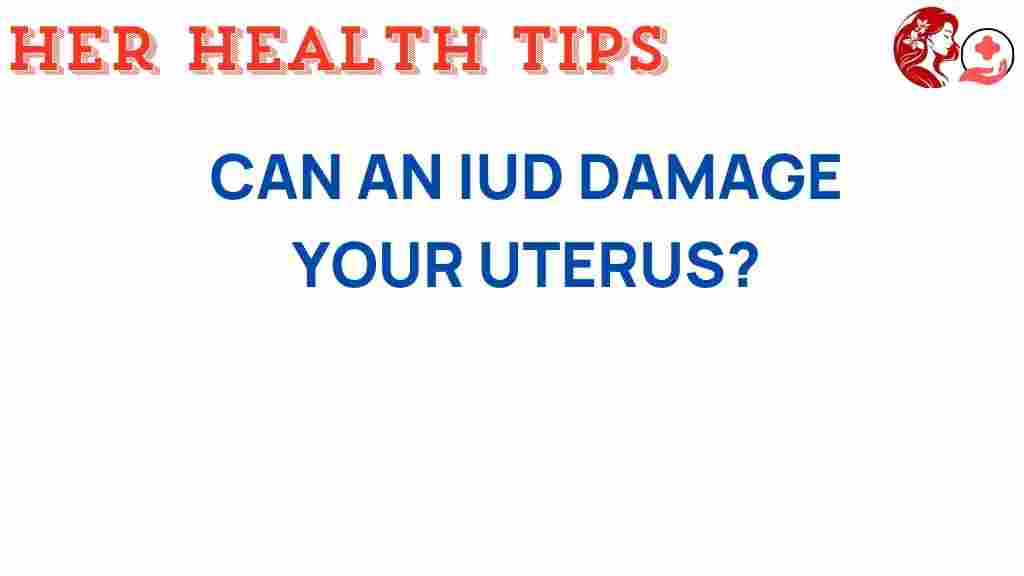Unraveling the Myths: Can an IUD Really Damage Your Uterus?
In recent years, intrauterine devices (IUDs) have gained popularity as a reliable form of birth control. However, many women still harbor concerns about their safety, particularly regarding uterine health. Myths surrounding the IUD and its potential to damage the uterus have circulated widely, leading to confusion and fear among those considering this form of contraception. In this article, we will explore these myths, discuss the realities of IUDs and their impact on women’s health, and provide medical advice for those contemplating this option.
What is an IUD?
An IUD is a small, T-shaped device that a healthcare provider inserts into the uterus to prevent pregnancy. It is a long-term, reversible form of birth control that can be hormonal or non-hormonal (copper). IUDs are known for their effectiveness, with a success rate of over 99% in preventing pregnancy.
Understanding Uterine Health
The uterus is a vital organ in the female reproductive system, playing a crucial role in menstruation and pregnancy. Maintaining uterine health is essential for women’s overall reproductive safety. Concerns about IUDs often stem from misunderstandings about how they interact with the uterus and their potential side effects.
Debunking Common Myths About IUDs and Uterine Health
Let’s take a closer look at some prevalent myths regarding IUDs and their ability to damage the uterus.
Myth 1: IUDs Cause Damage to the Uterus
One of the most significant fears is that IUDs can physically damage the uterus. However, research has shown that when properly inserted by a qualified healthcare provider, IUDs are safe and unlikely to cause any harm.
Myth 2: IUDs Lead to Infertility
Another common myth is that IUDs can lead to infertility. This is false. Studies indicate that fertility returns to normal quickly after IUD removal, and there is no evidence suggesting that IUDs cause long-term infertility.
Myth 3: IUDs Increase the Risk of Ectopic Pregnancy
While it is true that ectopic pregnancies can occur, the risk is lower among IUD users compared to women who do not use any form of contraception. The IUD’s mechanism of action helps prevent pregnancy in the first place, reducing the chances of an ectopic pregnancy.
How IUDs Work: A Step-by-Step Process
Understanding how IUDs function can help dispel myths about their safety. Here’s a breakdown of the process:
Step 1: Insertion
A healthcare provider will perform the insertion during a routine office visit. This procedure is generally quick, lasting only a few minutes.
Step 2: Mechanism of Action
The IUD works primarily by:
- Preventing sperm from fertilizing an egg: The copper IUD releases copper ions that are toxic to sperm, reducing their mobility and viability.
- Thickening cervical mucus: Hormonal IUDs thicken the cervical mucus, making it difficult for sperm to enter the uterus.
- Thinning the uterine lining: Hormonal IUDs also reduce the thickness of the uterine lining, making it less suitable for implantation.
Step 3: Duration of Use
IUDs can remain effective for several years, depending on the type. Copper IUDs can last up to 10-12 years, while hormonal IUDs typically last 3-7 years.
Step 4: Removal
Once the IUD’s lifespan is over, or if a woman wishes to conceive, a healthcare provider can easily remove the IUD. Fertility usually resumes immediately after removal.
Potential Side Effects and Troubleshooting Tips
<pWhile IUDs are generally safe, some women may experience side effects. Here are a few common issues and tips for managing them:
1. Cramping and Discomfort
Some women experience cramping after insertion. This usually subsides within a few days. If cramping persists, consult a healthcare provider.
2. Irregular Bleeding
It’s common to experience irregular bleeding in the initial months after insertion. This typically normalizes over time. If heavy bleeding occurs, seek medical advice.
3. Strings of the IUD
After insertion, you may feel the strings of the IUD during self-examination. If the strings feel longer or you cannot feel them, contact your healthcare provider to ensure the IUD is in place.
4. Risk of Expulsion
In rare cases, the IUD may be expelled from the uterus. If you suspect this, consult a healthcare provider to check the position of the IUD.
When to Seek Medical Advice
It’s crucial to be aware of when to seek medical advice regarding your IUD:
- If you experience severe pain that does not improve.
- If you have unusually heavy bleeding or bleeding that lasts longer than your normal period.
- If you suspect you may be pregnant while using an IUD.
- If you have signs of infection, such as fever or unusual discharge.
For more information on IUDs, consult your healthcare provider or visit reputable sources like the Planned Parenthood website.
Conclusion: Understanding the Truth About IUDs and Uterine Health
In conclusion, the myths surrounding IUDs often lead to unnecessary fear and hesitation among women considering this effective form of contraception. Understanding the facts about IUDs, their mechanism of action, and their impact on uterine health can empower women to make informed decisions about their reproductive safety.
It’s essential to discuss any concerns with a healthcare provider who can provide personalized medical advice. By debunking the myths and understanding the realities of IUD use, women can confidently choose the best birth control method for their needs.
For more insights on women’s health and reproductive safety, explore additional resources or talk to a healthcare professional today.
This article is in the category Reproductive and created by HerHealthTips Team
